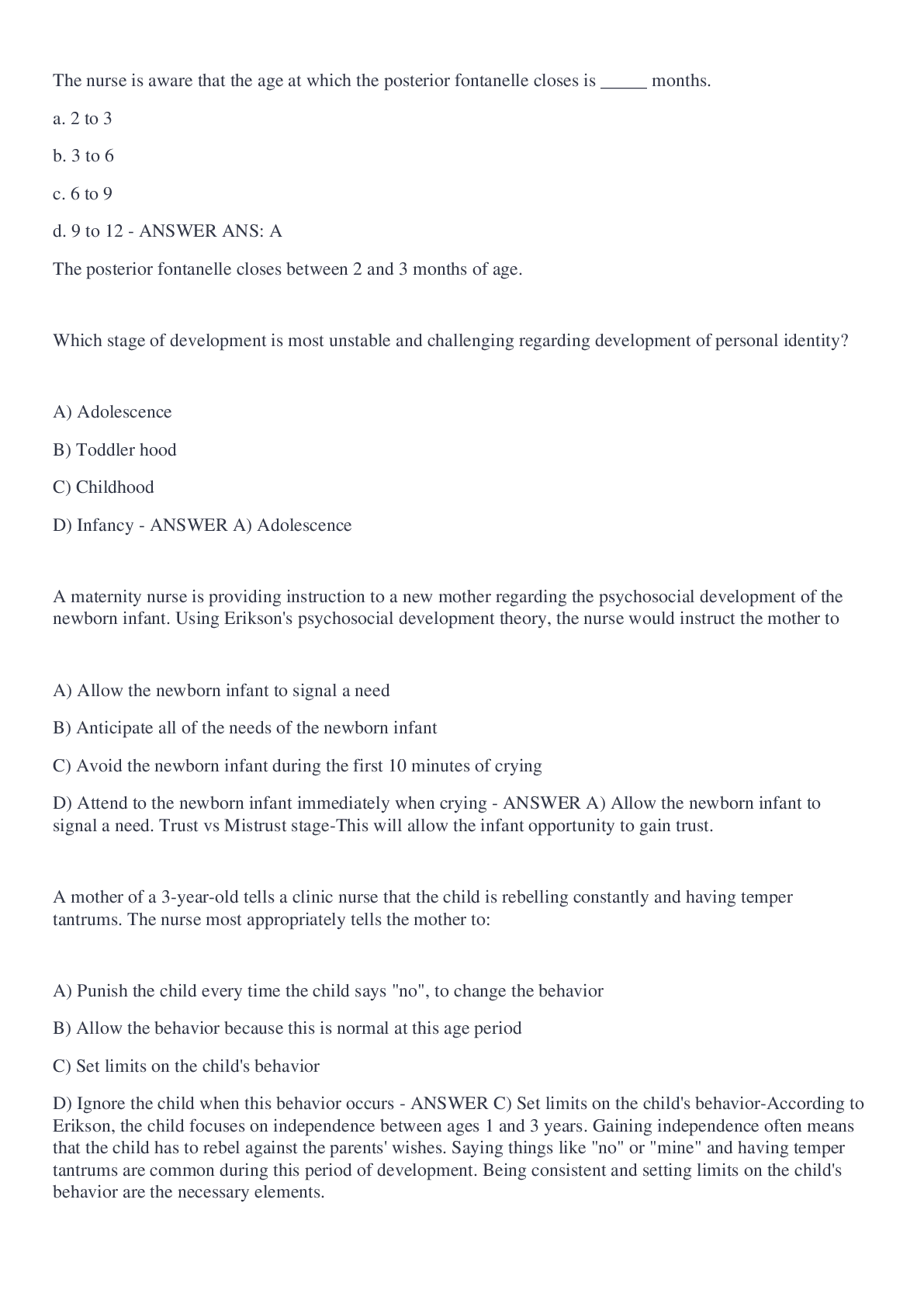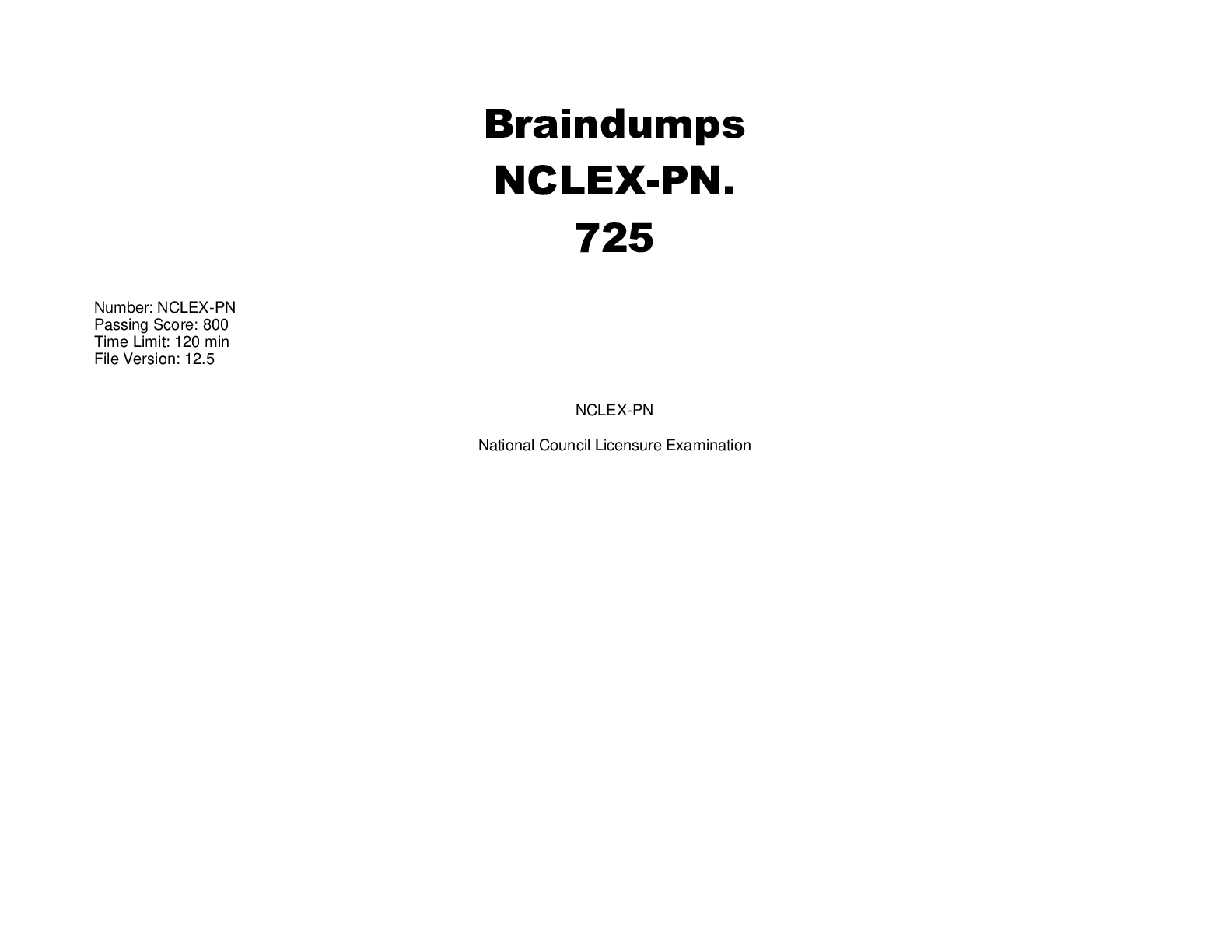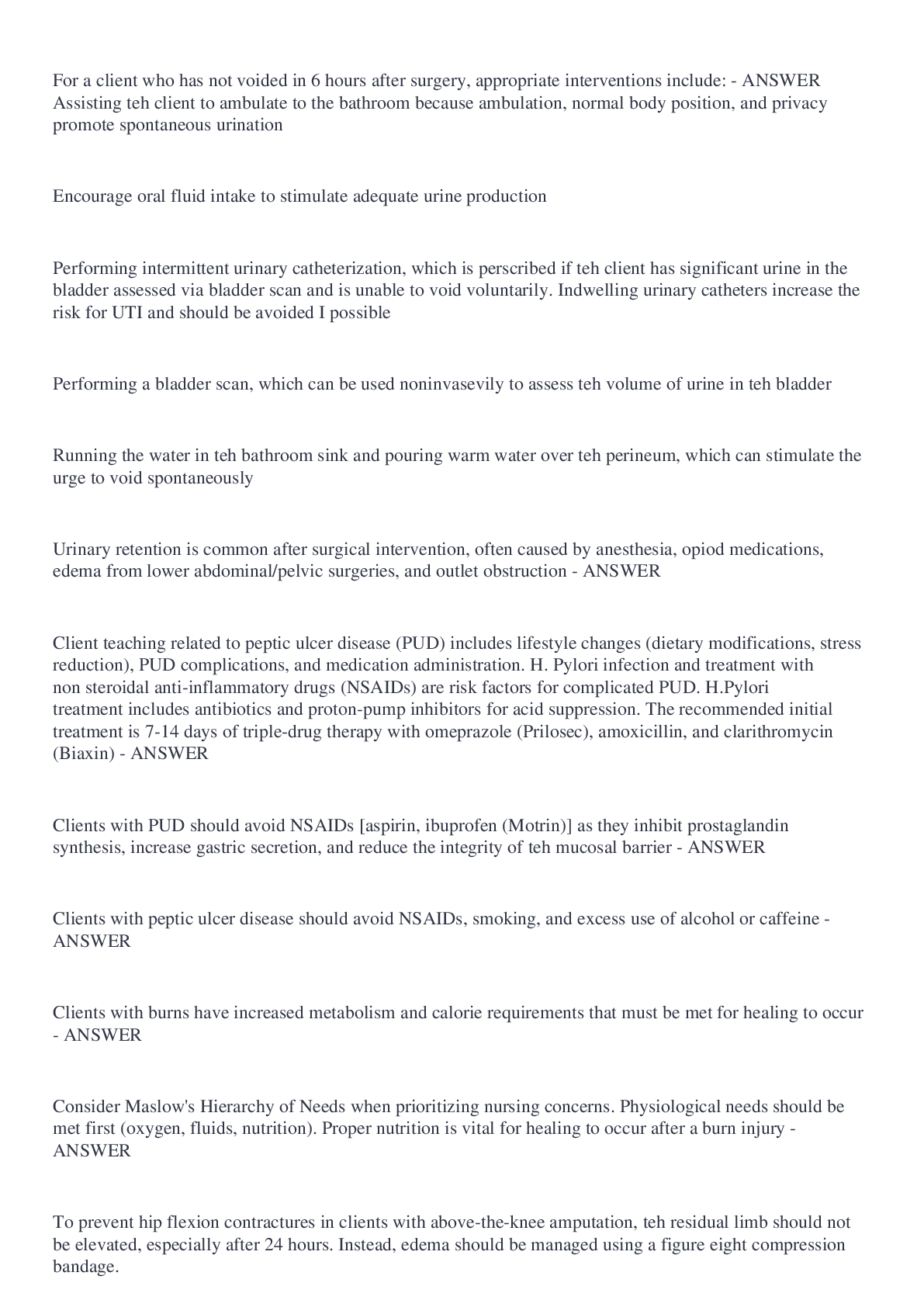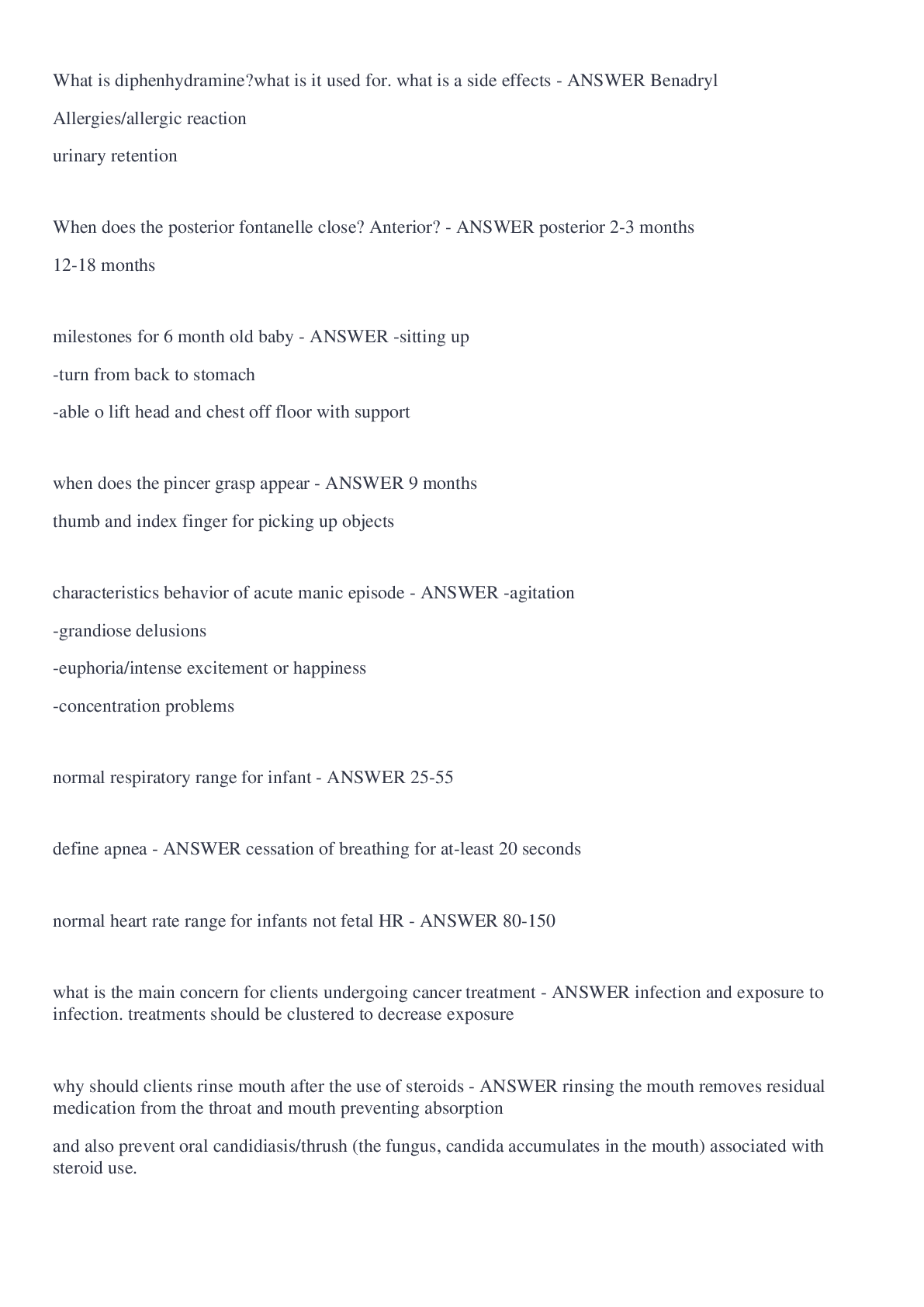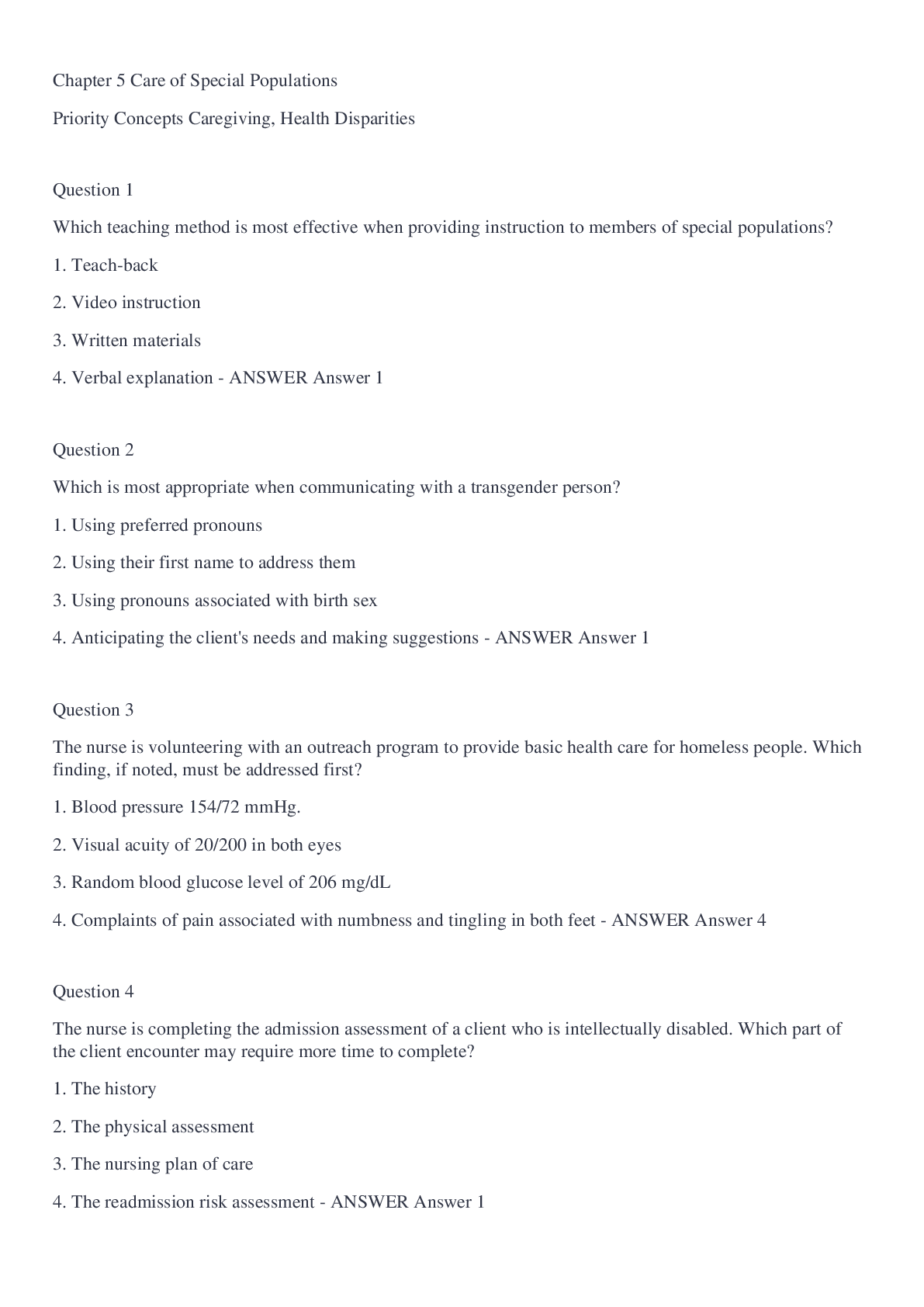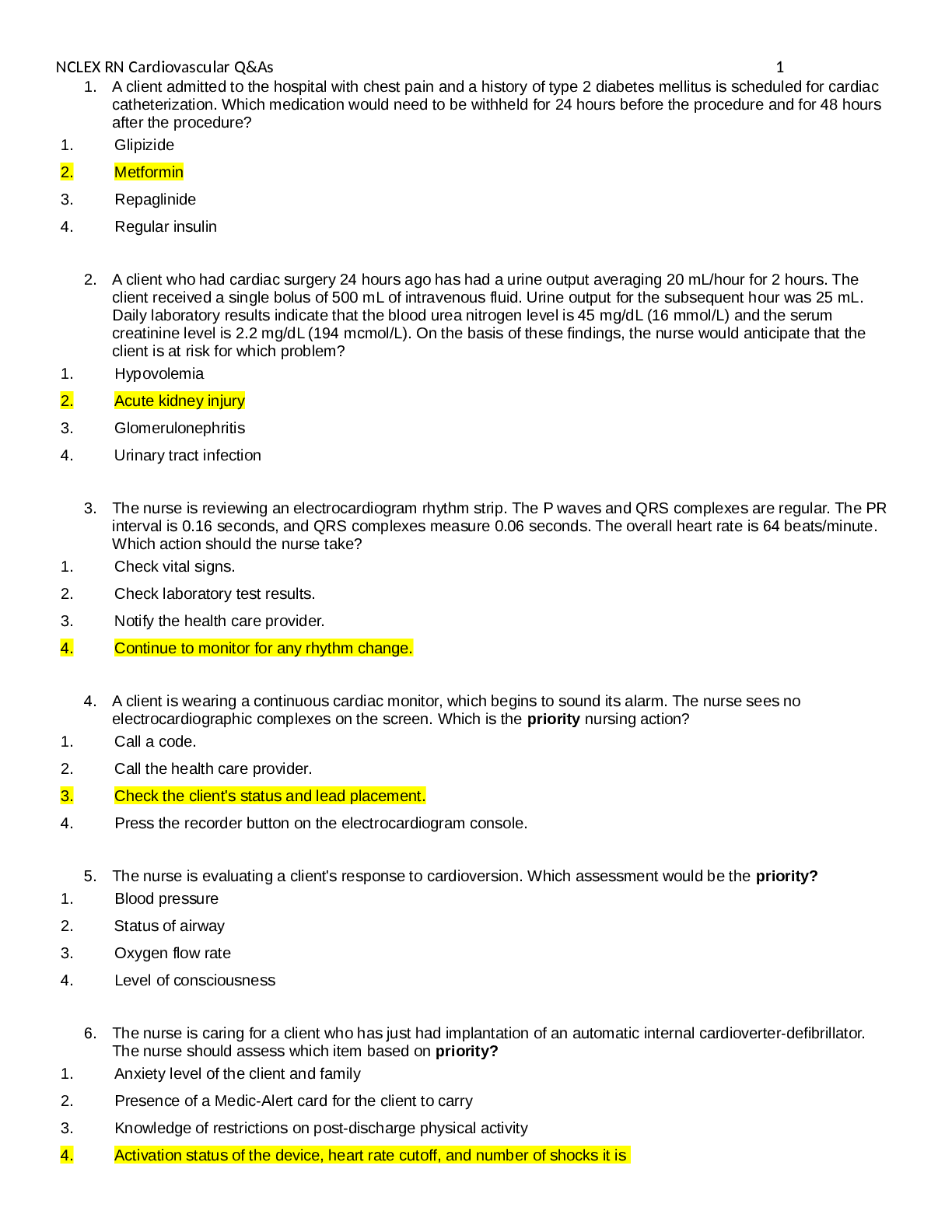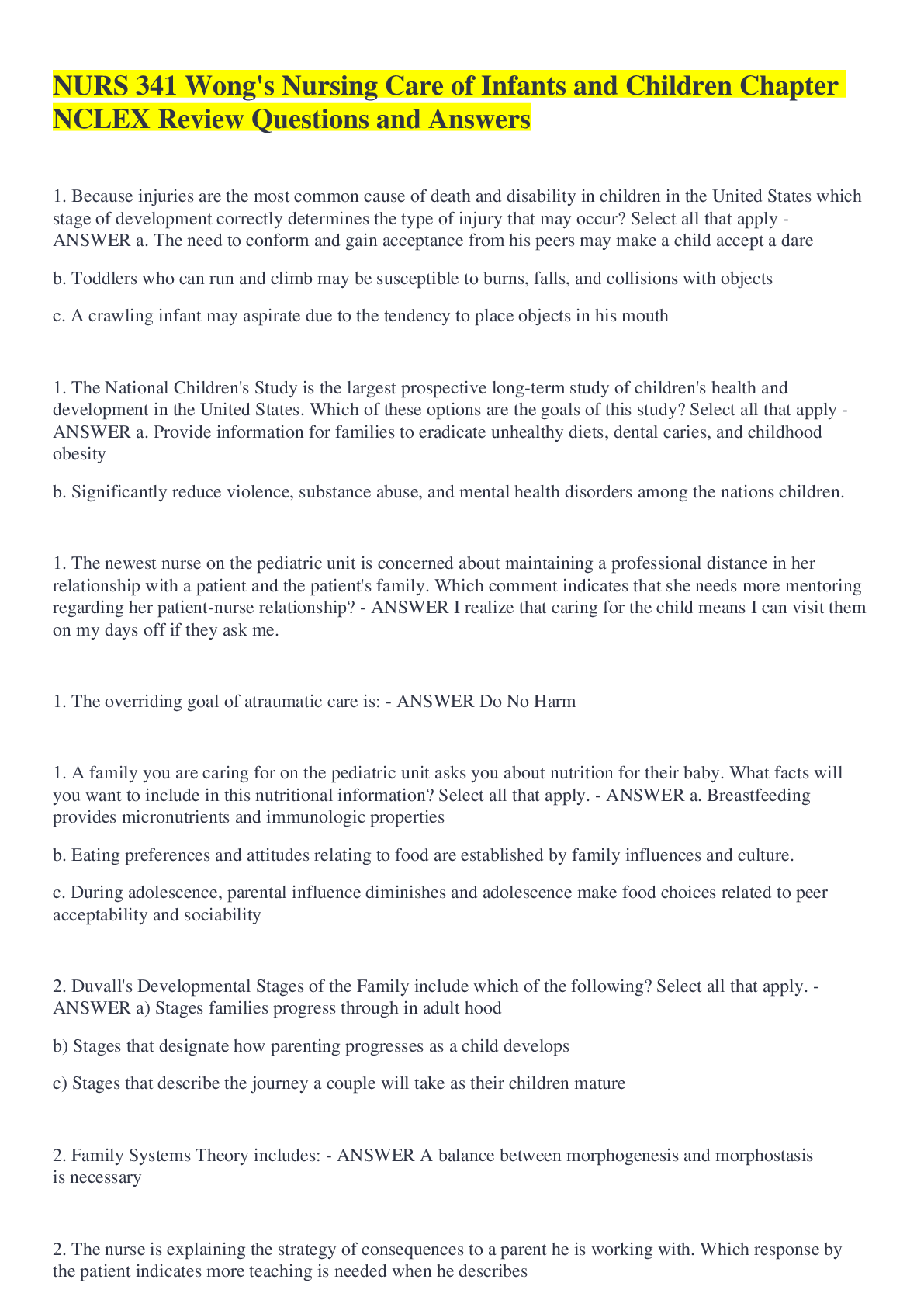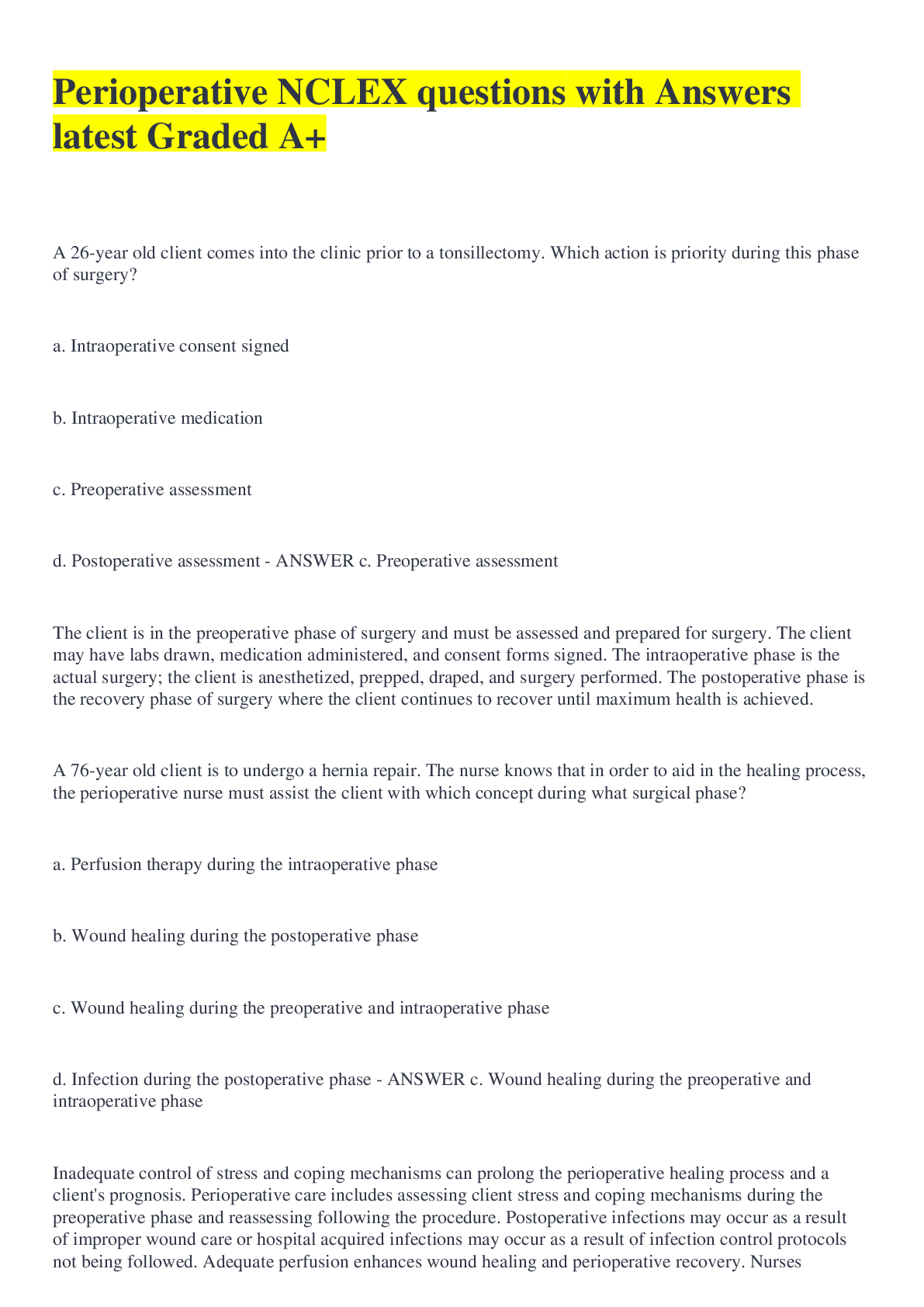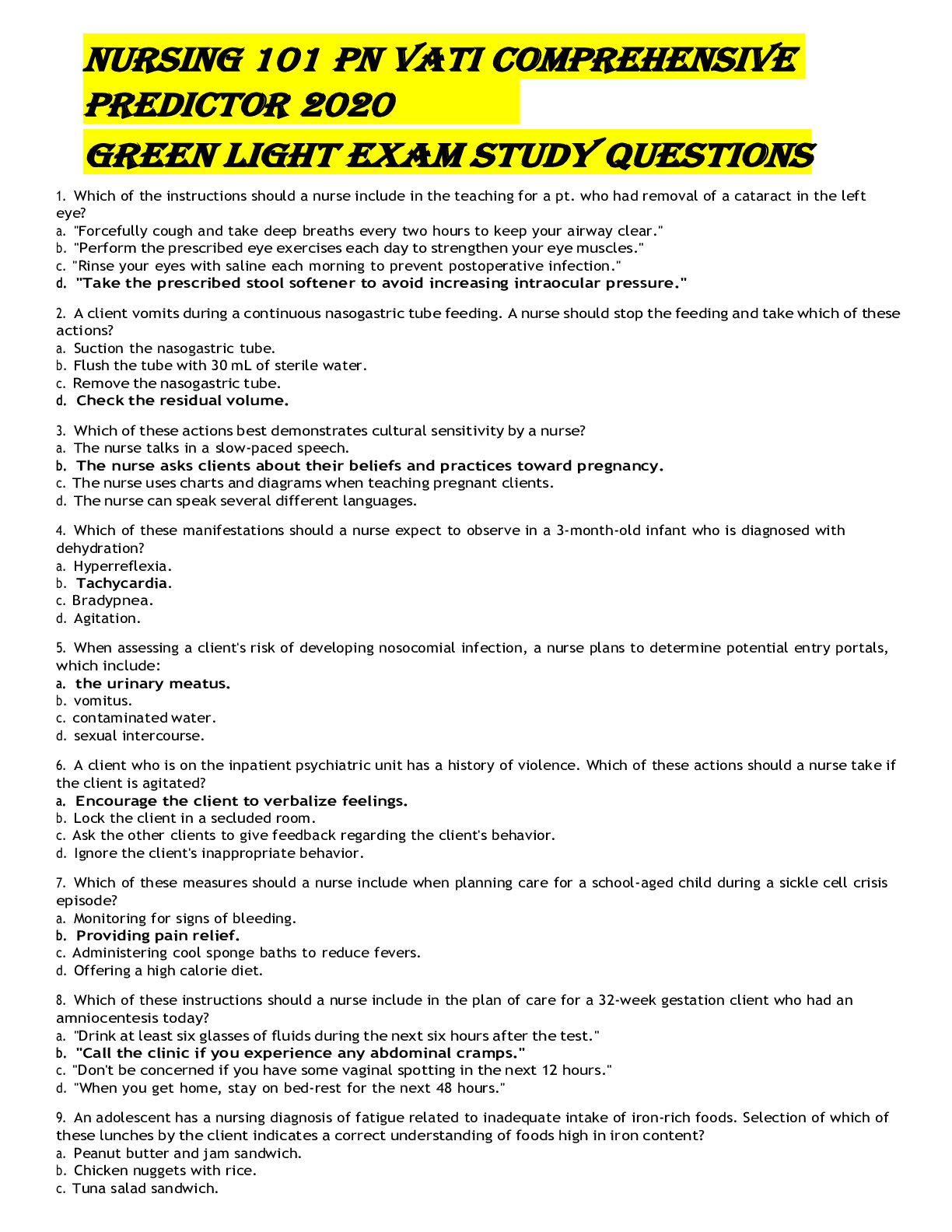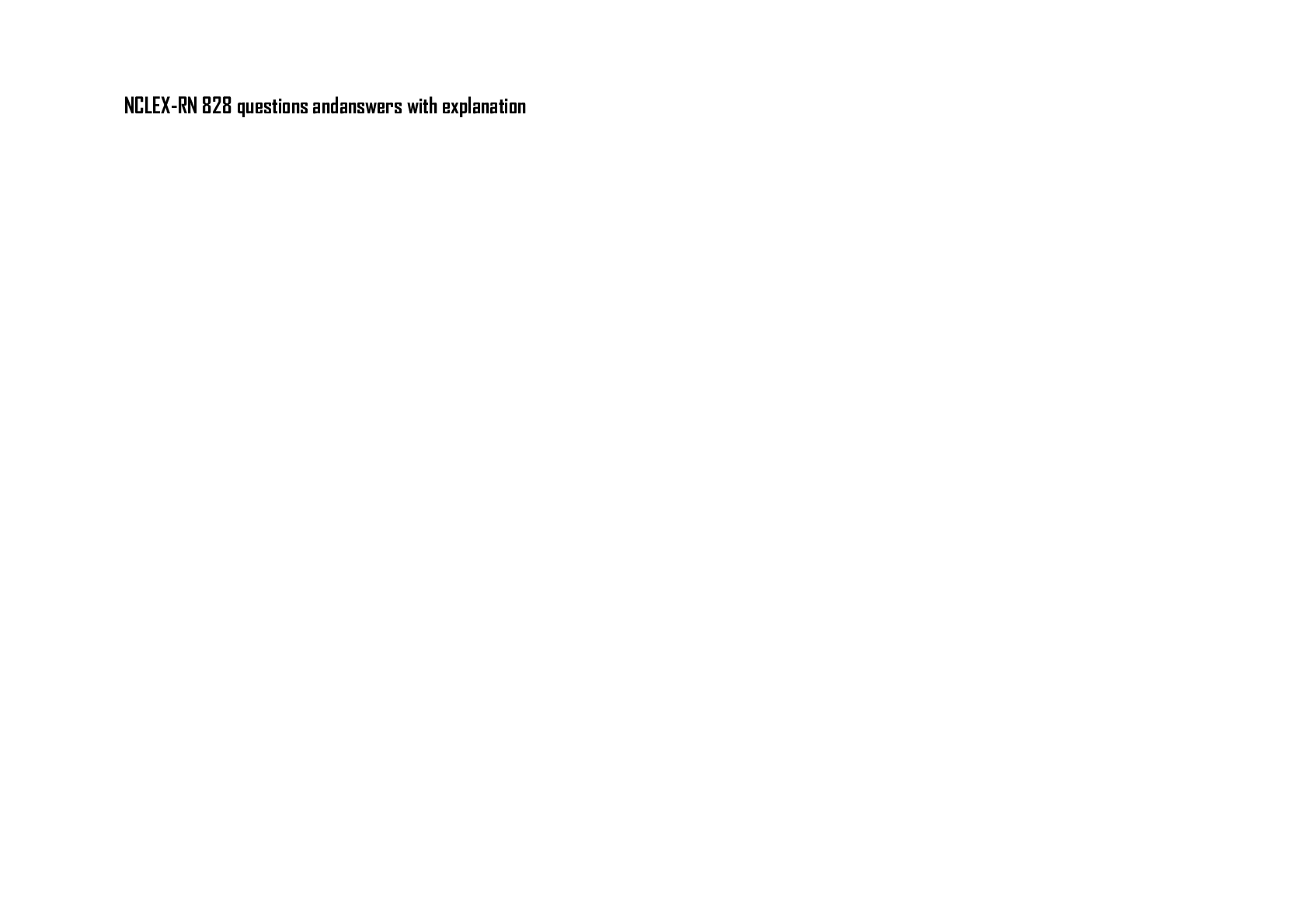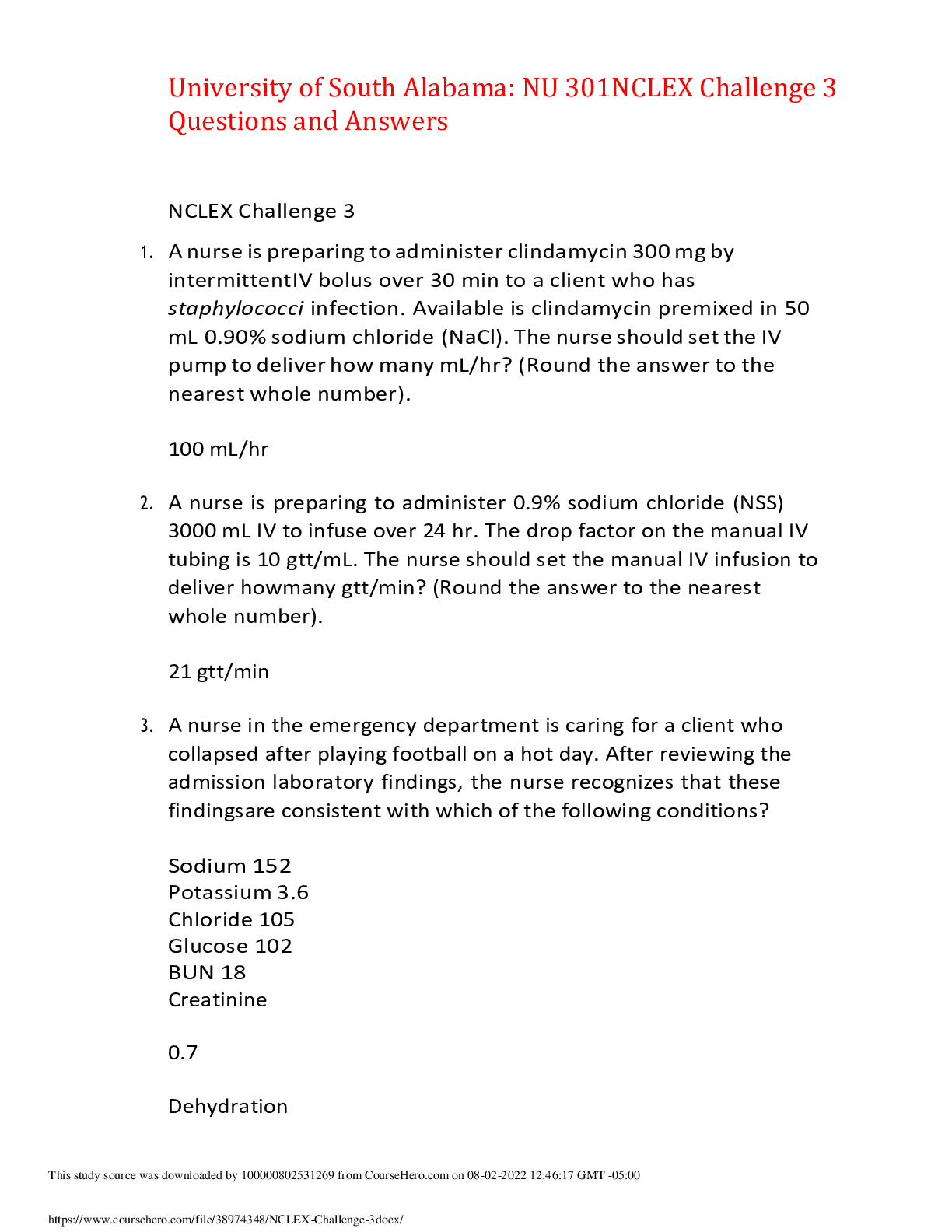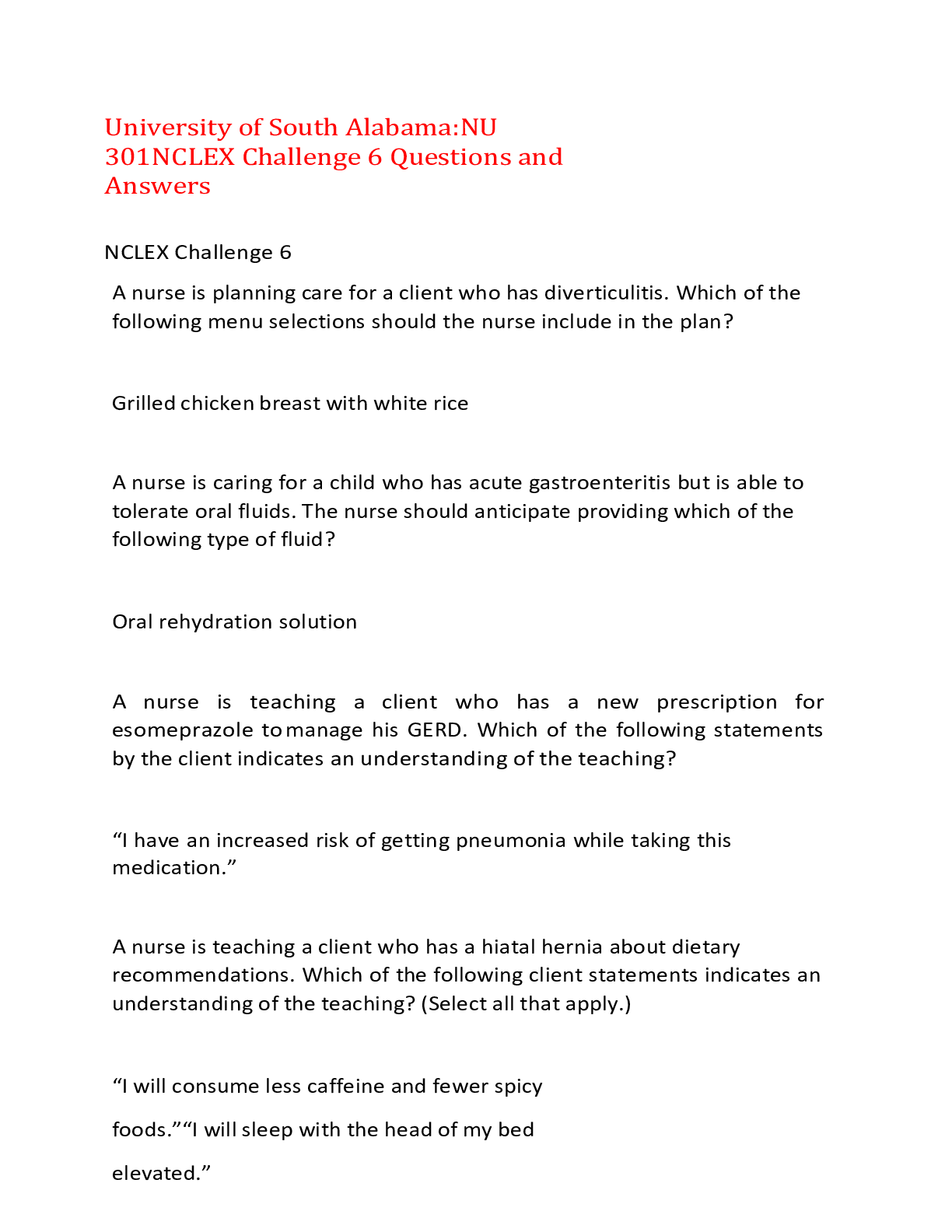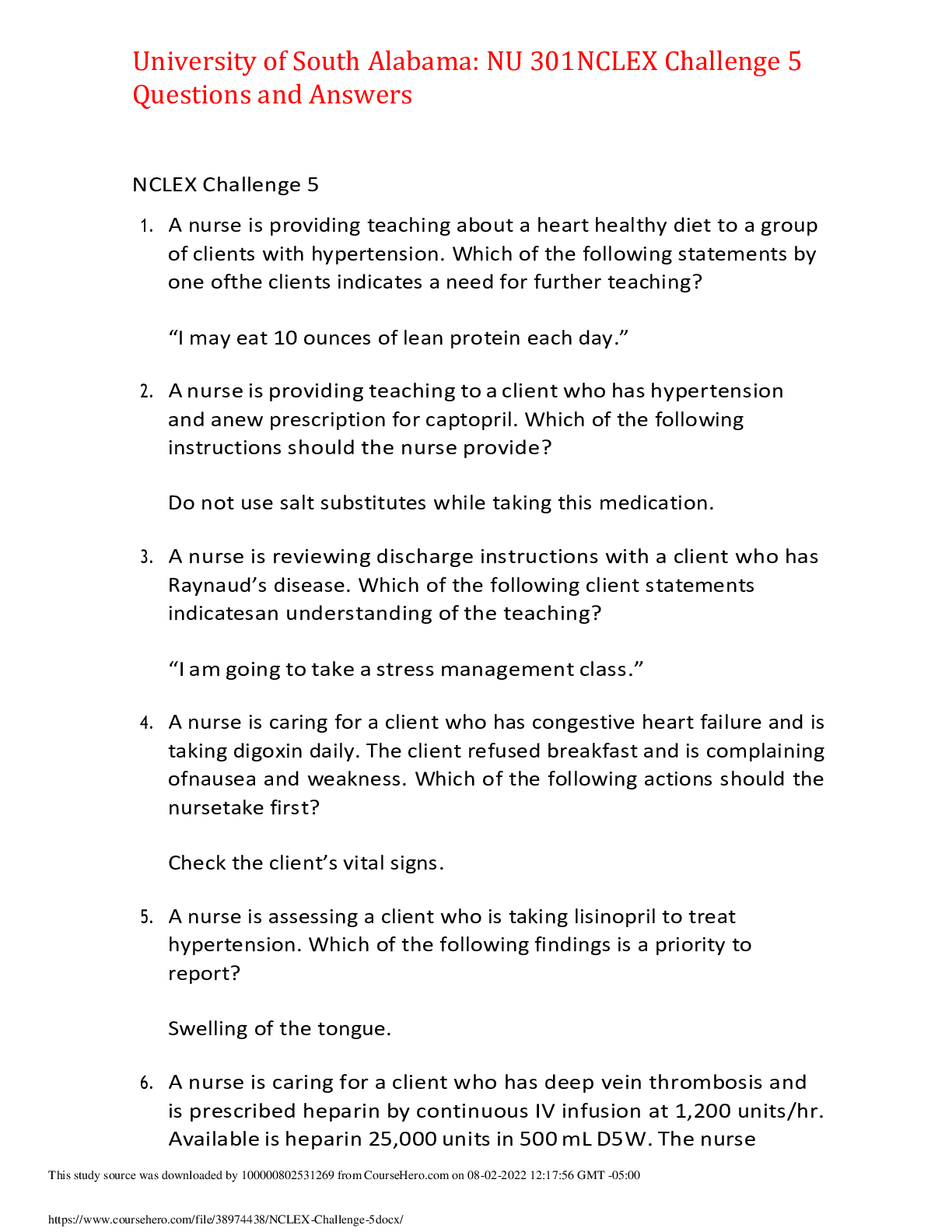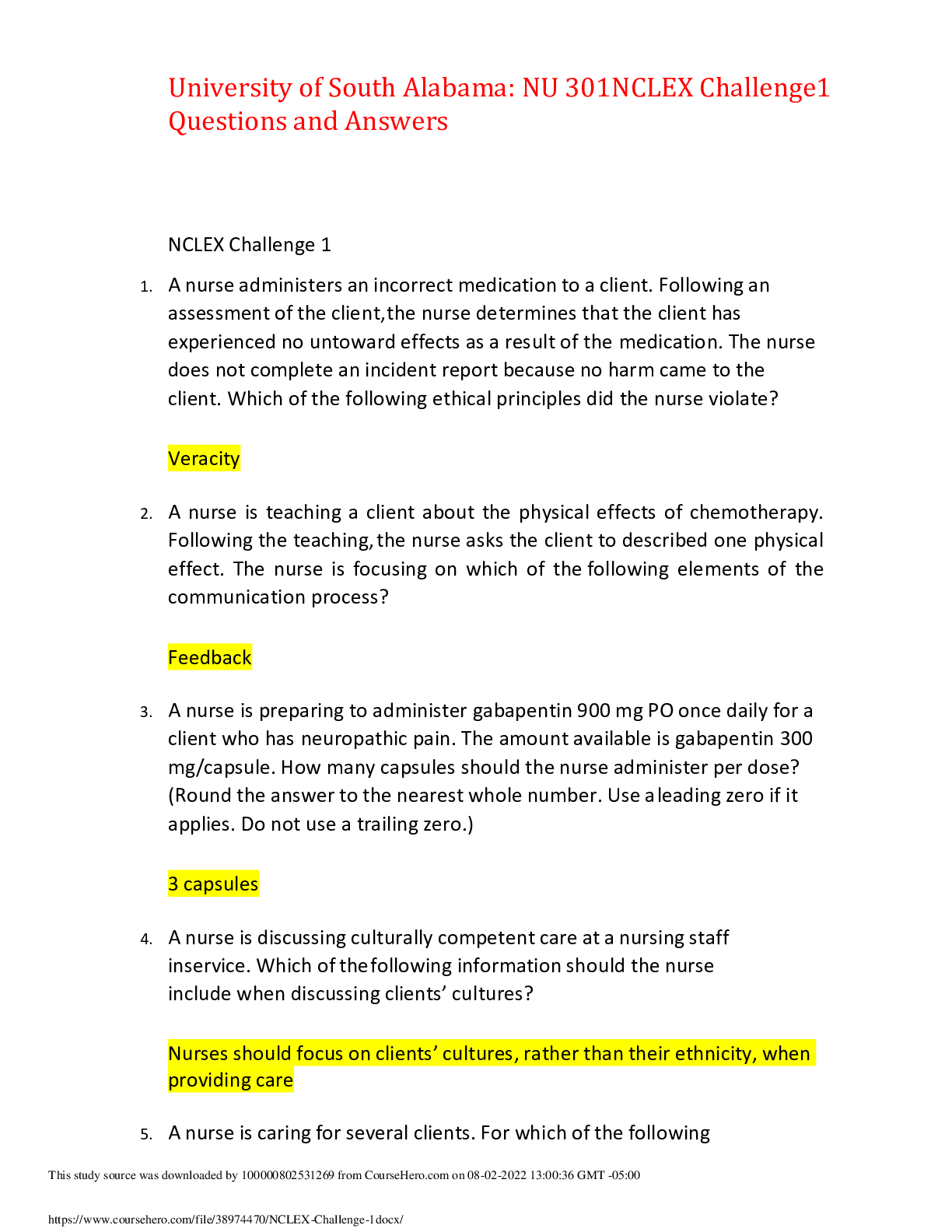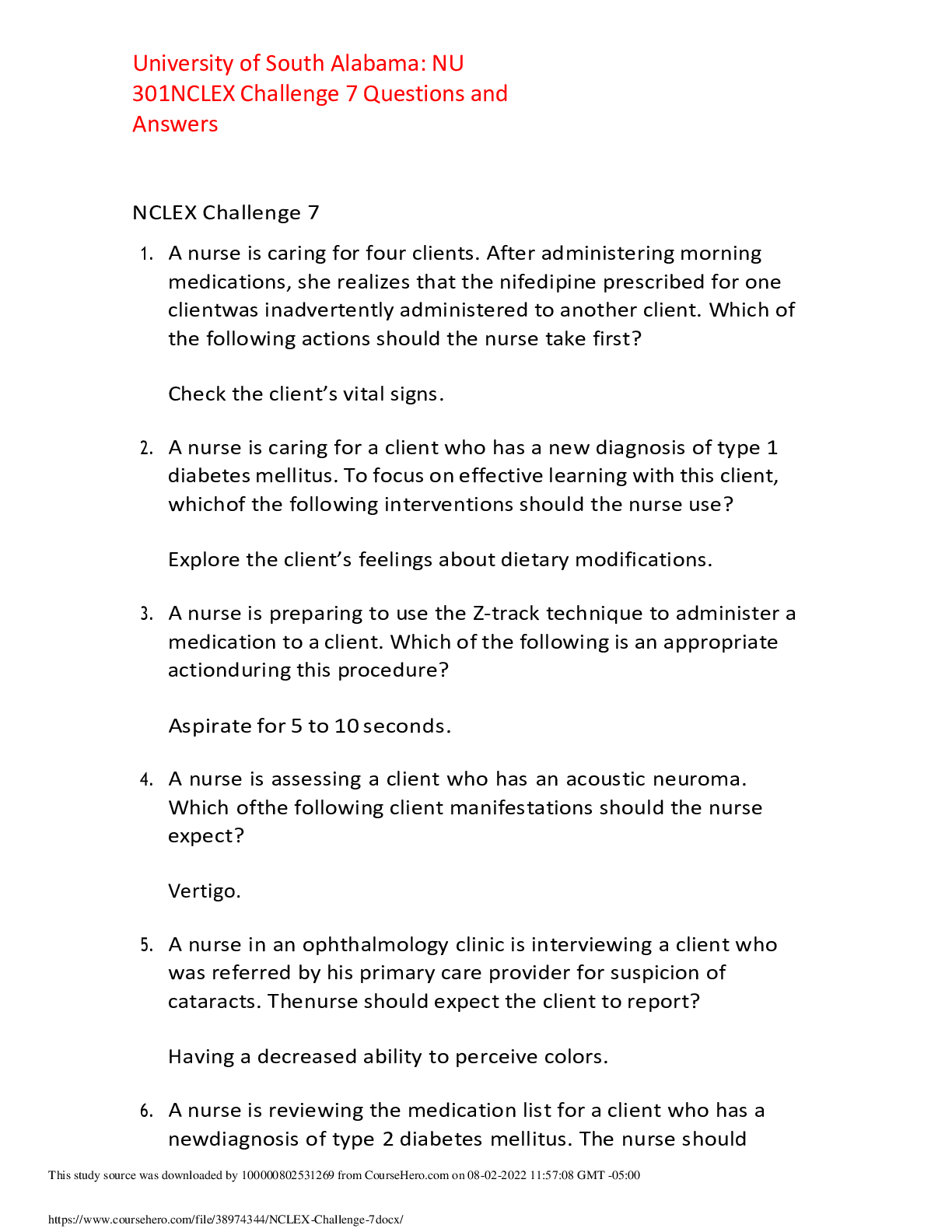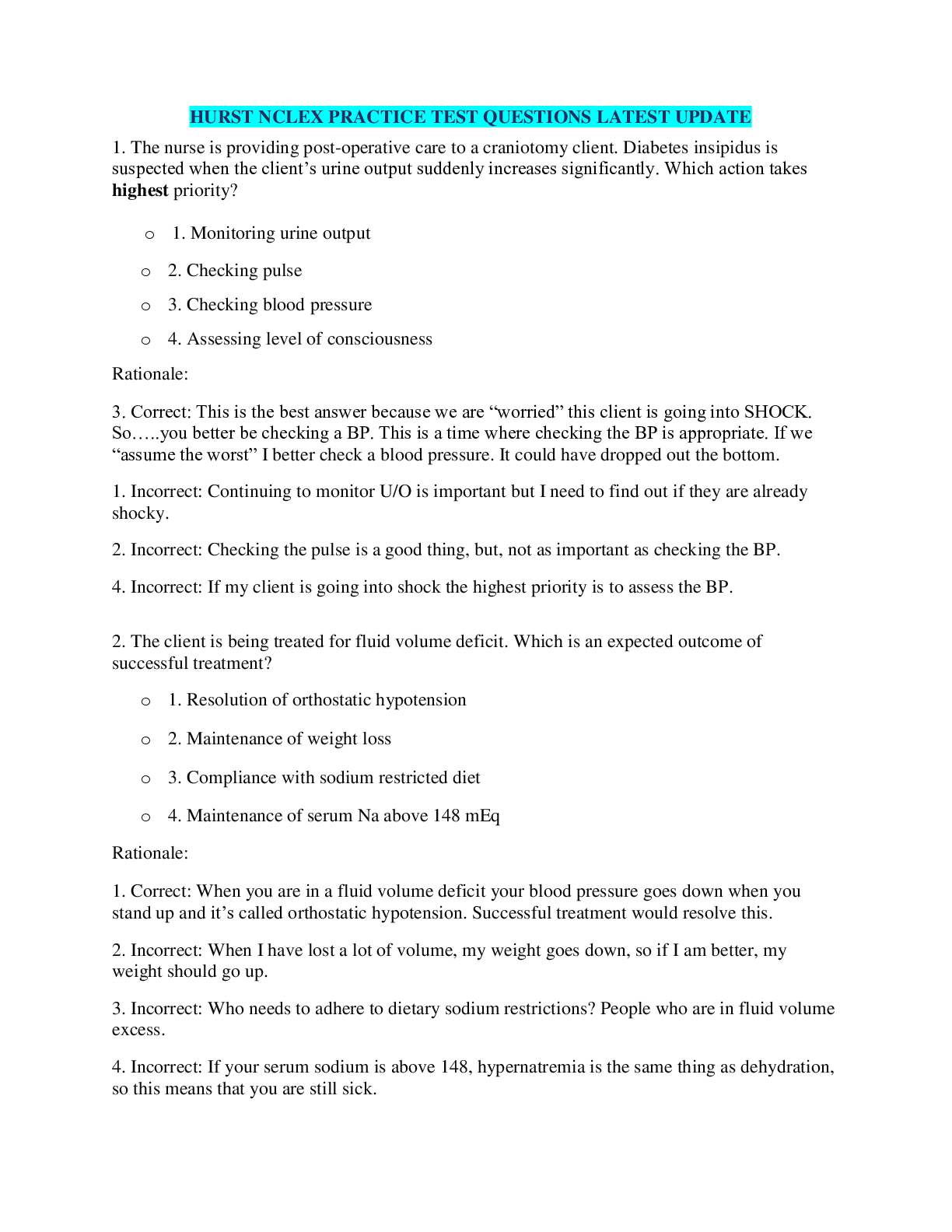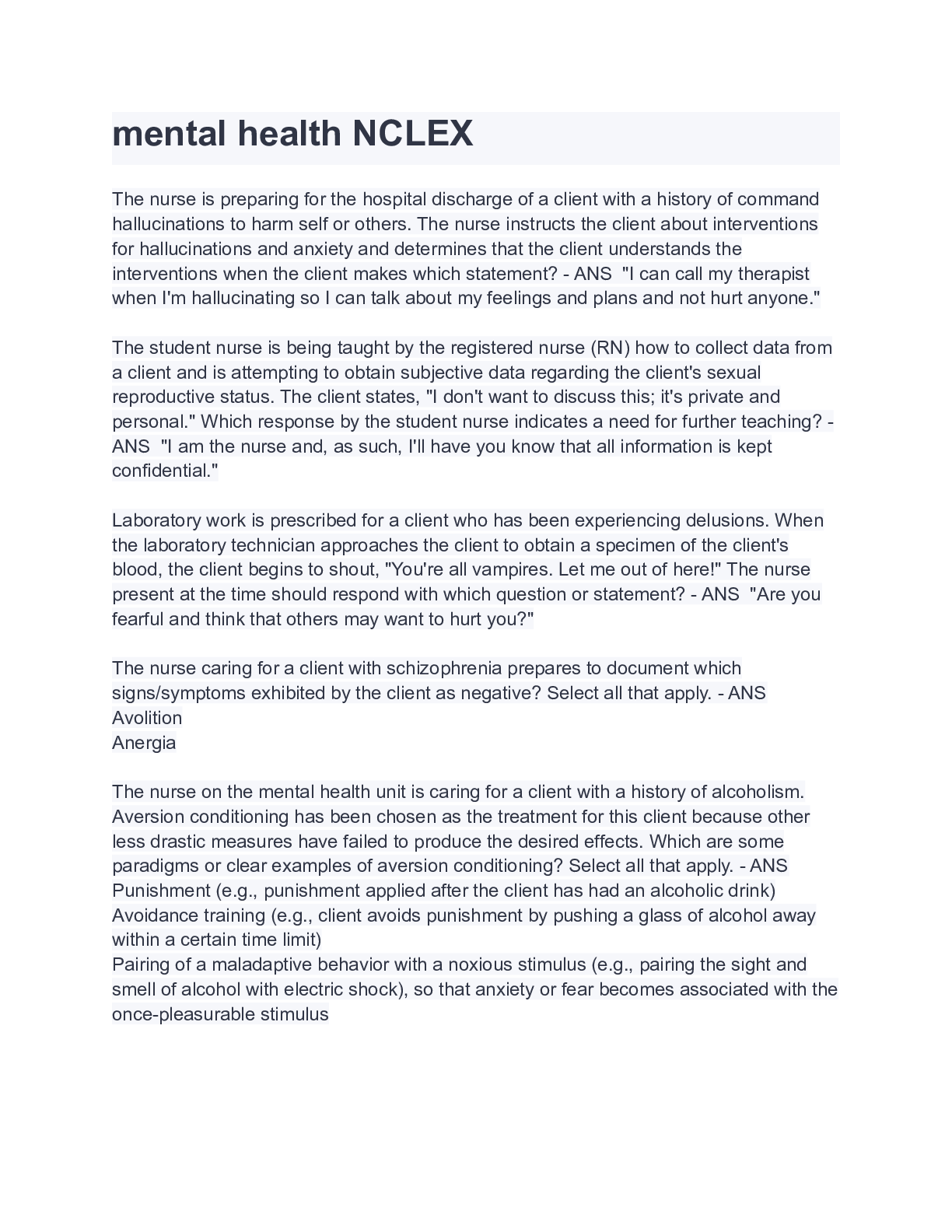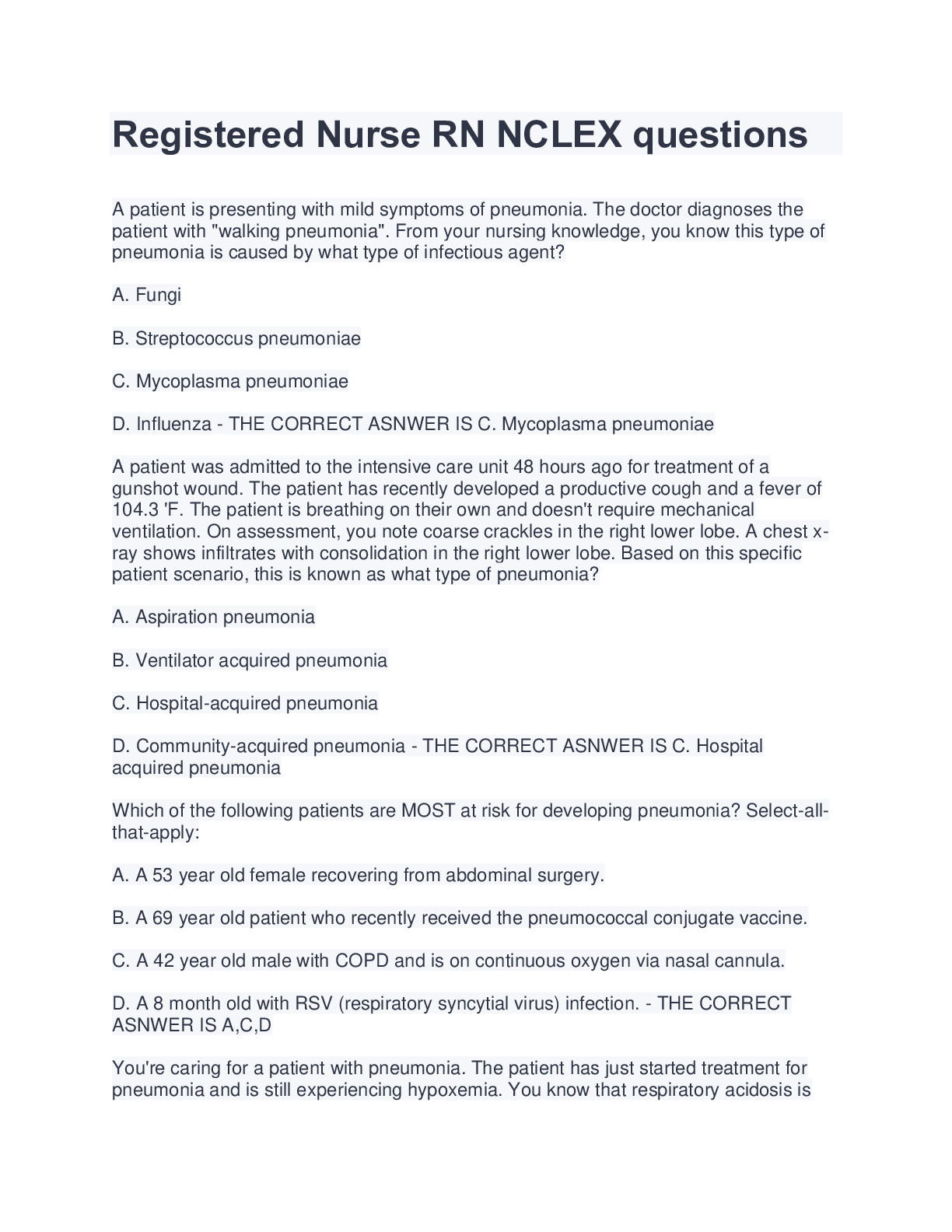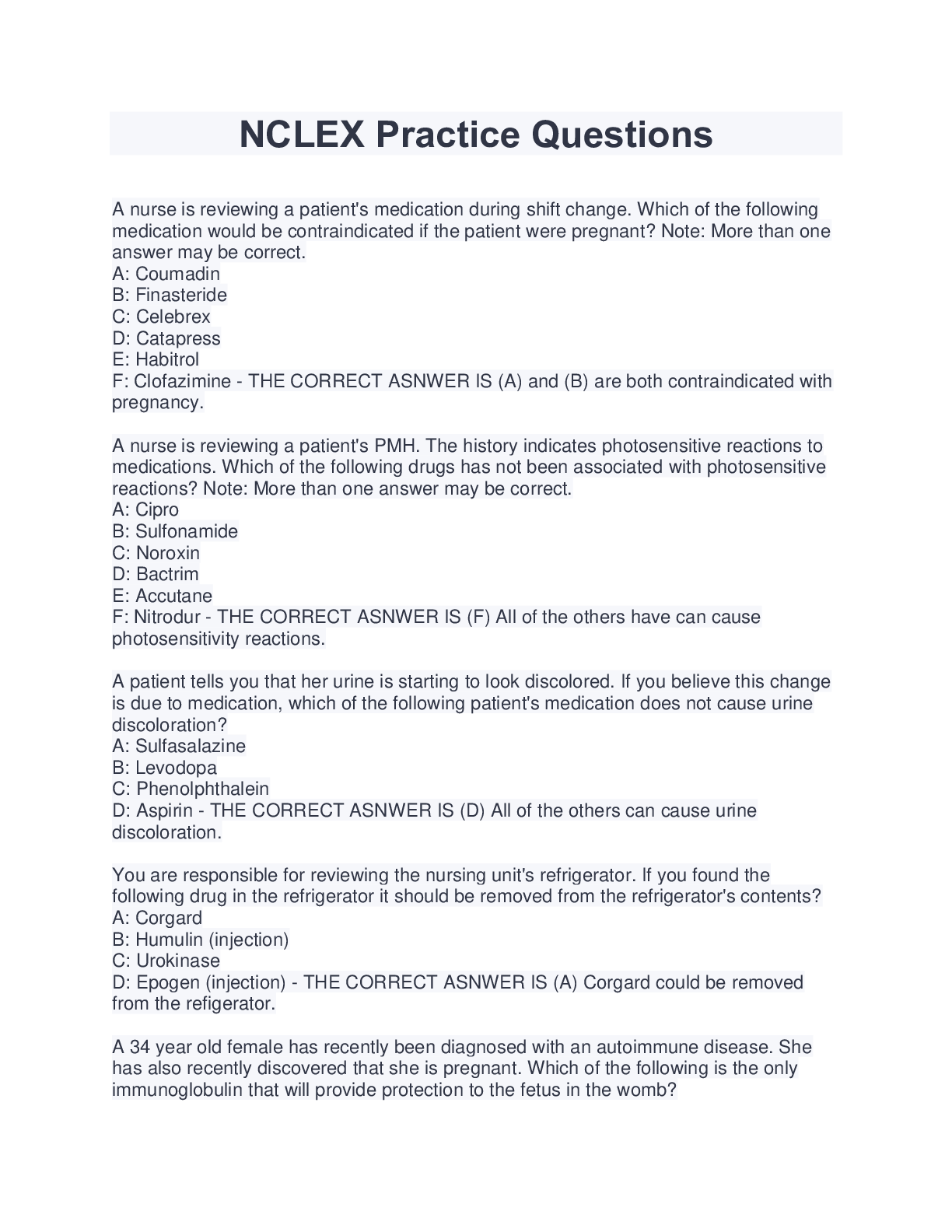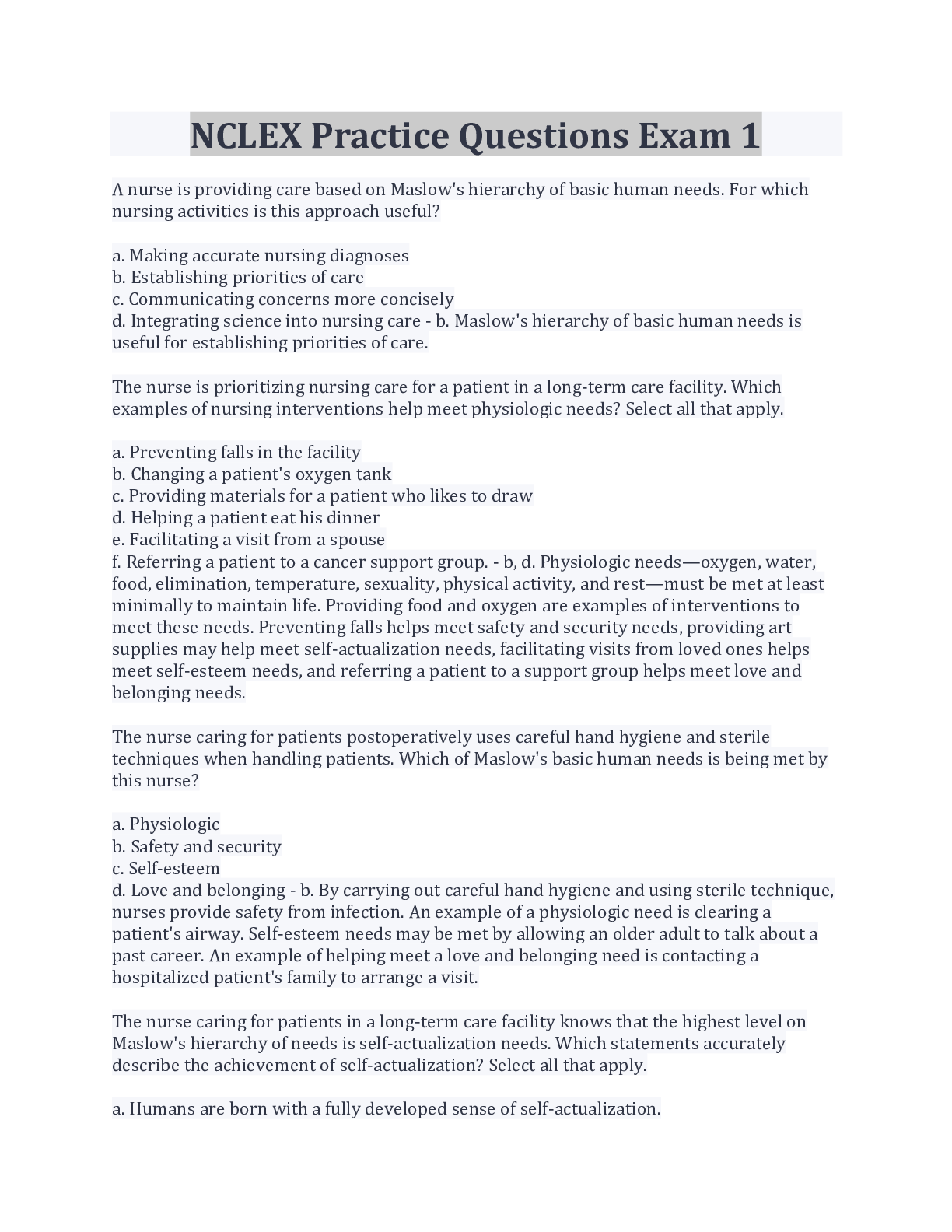Exam 3: Normal Postpartum NCLEX Questions and Answers
Document Content and Description Below
1 - ANSWER A 3-day-breastfeeding client who is not immune to rubella is to receive the rubella vaccine at discharge. Which of the following must the nurse include in her discharge teaching regarding t... he vaccine? 1. The woman should not become pregnant for at least 4 weeks. 2. The woman should pump and dump her breast milk for 1 week. 3. Surgical masks must be worn by the mother when she holds the baby. 4. Antibodies transported through the breast milk will protect the baby 1 - ANSWER A 3-day-postpartum client questions why she is to receive the rubella vaccine before leaving the hospital. Which of the following rationales should guide the nurse's response? 1. The client's obstetric status is optimal for receiving the vaccine. 2. The client's immune system is highly responsive during the postpartum period. 3. The client's baby will be high risk for acquiring rubella if the woman does not receive the vaccine. 4. The client's insurance company will pay for the shot if it is given during the immediate postpartum period. 4 - ANSWER A patient, G2 P1102, who delivered her baby 8 hours ago, now has a temperature of 100.2°F. Which of the following is the appropriate nursing intervention at this time? 1. Notify the doctor to get an order for acetaminophen. 2. Request an infectious disease consult from the doctor. 3. Provide the woman with cool compresses. 4. Encourage intake of water and other fluids. 2 - ANSWER To prevent infection, the nurse teaches the postpartum client to perform which of the following tasks? 1. Apply antibiotic ointment to the perineum daily. 2. Change the peripad at each voiding. 3. Void at least every two hours. 4. Spray the perineum with povidone-iodine after toileting. 1 - ANSWER A 3-day-postpartum breastfeeding woman is being assessed. Her breasts are firm and warm to the touch. When asked when she last fed the baby her reply is, "I fed the baby last evening. I let the nurses feed him in the nursery last night. I needed to rest." Which of the following actions should the nurse take at this time? 1. Encourage the woman exclusively to breastfeed her baby. 2. Have the woman massage her breasts hourly. 3. Obtain an order to culture her expressed breast milk. 4. Take the temperature and pulse rate of the woman. 2 - ANSWER A breastfeeding woman has been counseled on how to prevent engorgement. Which of the following actions by the mother shows that the teaching was effective? 1. She pumps her breasts after each feeding. 2. She feeds her baby every 2 to 3 hours. 3. She feeds her baby 10 minutes on each side. 4. She supplements each feeding with formula. 4 - ANSWER A 2-day-postpartum breastfeeding woman states, "I am sick of being fat. When can I go on a diet?" Which of the following responses is appropriate? 1. "It is fine for you to start dieting right now as long as you drink plenty of milk." 2. "Your breast milk will be low in vitamins if you start to diet while breastfeeding." 3. "You must eat at least 3,000 calories per day in order to produce enough milk for your baby." 4. "Many mothers lose weight when they breastfeed because the baby consumes about 600 calories a day." 4 - ANSWER A G2 P2002, who is postpartum 6 hours from a spontaneous vaginal delivery, is assessed. The nurse notes that the fundus is firm at the umbilicus, there is heavy lochia rubra, and perineal sutures are intact. Which of the following actions should the nurse take at this time? 1. Do nothing. This is a normal finding. 2. Massage the woman's fundus. 3. Take the woman to the bathroom to void. 4. Notify the woman's primary health care provider. 4 5 - ANSWER A client informs the nurse that she intends to bottle feed her baby. Which of the following actions should the nurse encourage the client to perform? Select all that apply. 1. Increase her fluid intake for a few days. 2. Massage her breasts every 4 hours. 3. Apply heat packs to her axillae. 4. Wear a supportive bra 24 hours a day. 5. Stand with her back toward the shower water. 1 - ANSWER The nurse in the obstetric clinic received a telephone call from a bottle-feeding mother of a 3-day-old. The client states that her breasts are firm, red, and warm to the touch. Which of the following is the best action for the nurse to advise the client to perform? 1. Intermittently apply ice packs to her axillae and breasts. 2. Apply lanolin to her breasts and nipples every 3 hours. 3. Express milk from the breasts every 3 hours. 4. Ask the primary health care provider to order a milk suppressant. 4 - ANSWER A multigravid, postpartum woman reports severe abdominal cramping whenever she nurses her baby. Which of the following responses by the nurse is appropriate? 1. Suggest that the woman bottle feed for a few days. 2. Instruct the patient on how to massage her fundus. 3. Instruct the patient to feed using an alternate position. 4. Discuss the action of breastfeeding hormones. 4 - ANSWER The nurse is caring for a breastfeeding mother who asks advice on foods that will provide both vitamin A and iron. Which of the following should the nurse recommend? 1. 1/2 cup raw celery dipped in 1 ounce cream cheese. 2. 8 ounce yogurt mixed with 1 medium banana. 3. 12 ounce strawberry milk shake. 4. 1 1/2 cup raw broccoli 3 - ANSWER A breastfeeding mother states that she has sore nipples. In response to the complaint, the nurse assists with "latch on" and recommends that the mother do which of the following? 1. Use a nipple shield at each breastfeeding. 2. Cleanse the nipples with soap 3 times a day. 3. Rotate the baby's positions at each feed. 4. Bottle feed for 2 days then resume breastfeeding 2 - ANSWER Which of the following statements is true about breastfeeding mothers as compared to bottle-feeding mothers? 1. Breastfeeding mothers usually involute completely by 3 weeks postpartum. 2. Breastfeeding mothers have decreased incidence of diabetes mellitus later in life. 3. Breastfeeding mothers show higher levels of bone density after menopause. 4. Breastfeeding mothers are prone to fewer bouts of infection immediately postpartum 2 - ANSWER A breastfeeding woman, 1 1/2 months postdelivery, calls the nurse in the obstetrician's office and states, "I am very embarrassed but I need help. Last night I had an orgasm when my husband and I were making love. You should have seen the milk. We were both soaking wet. What is wrong with me?" The nurse should base the response to the client on which of the following? 1. The woman is exhibiting signs of pathological galactorrhea. 2. The same hormone stimulates orgasms and the milk ejection reflex. 3. The woman should have a serum galactosemia assessment done. 4. The baby is stimulating the woman to produce too much milk. 1 - ANSWER A client who is 3 days postpartum asks the nurse, "When may my husband and I begin having sexual relations again?" The nurse should encourage the couple to wait until after which of the following has occurred? 1. The client has had her six-week postpartum checkup. 2. The episiotomy has healed and the lochia has stopped. 3. The lochia has turned to pink and the vagina is no longer tender. 4. The client has had her first postpartum menstrual period. 3 - ANSWER A breastfeeding client, 7 weeks postpartum, complains to an obstetrician's triage nurse that when she and her husband had intercourse after the delivery, "I couldn't stand it. It was so painful. The doctor must have done something terrible to my vagina." Which of the following responses by the nurse is appropriate? 1. "After a delivery the vagina is always very tender. It should feel better the next time you have intercourse." 2. "Does your baby have thrush? If so, you should be assessed for a yeast infection in your vagina." 3. "Women who breastfeed often have vaginal dryness. A vaginal lubricant may remedy your discomfort." 4. "Sometimes the stitches of episiotomies heal too tight. Why don't you come in to be checked?" 3 - ANSWER The nurse monitors his or her postpartum clients carefully because which of the following physiological changes occurs during the early postpartum period? 1. Decreased urinary output. 2. Increased blood pressure. 3. Decreased blood volume. 4. Increased estrogen level. 3 - ANSWER A woman, 24 hours postpartum, is complaining of profuse diaphoresis. She has no other complaints. Which of the following actions by the nurse is appropriate? 1. Take the woman's temperature. 2. Advise the woman to decrease her fluid intake. 3. Reassure the woman that this is normal. 4. Notify the neonate's pediatrician. 2 - ANSWER Which of the following laboratory values would the nurse expect to see in a normal postpartum woman? 1. Hematocrit, 39%. 2. White blood cell count, 16,000 cells/mm3. 3. Red blood cell count, 5 million cells/mm3. 4. Hemoglobin, 15 grams/dL. 2 - ANSWER The nurse is discussing the importance of doing Kegel exercises during the postpartum period. Which of the following should be included in the teaching plan? 1. She should repeatedly contract and relax her rectal and thigh muscles. 2. She should practice by stopping the urine flow midstream every time she voids. 3. She should get on her hands and knees whenever performing the exercises. 4. She should be taught that toned pubococcygeal muscles decrease blood loss. 4 - ANSWER The nurse is evaluating the involution of a woman who is 3 days postpartum. Which of the following findings would the nurse evaluate as normal? 1. Fundus 1 cm above the umbilicus, lochia rosa. 2. Fundus 2 cm above the umbilicus, lochia alba. 3. Fundus 2 cm below the umbilicus, lochia rubra. 4. Fundus 3 cm below the umbilicus, lochia serosa. 2 - ANSWER During a home visit, the nurse assesses a client 2 weeks after delivery. Which of the following signs/symptoms should the nurse expect to see? 1. Diaphoresis. 2. Lochia alba. 3. Cracked nipples. 4. Hypertension. 3 - ANSWER The day after delivery, a woman, whose fundus is firm at 1 cm below the umbilicus and who has moderate lochia, tells the nurse that something must be wrong: "All I do is go to the bathroom." Which of the following is an appropriate nursing response? 1. Catheterize the client per doctor's orders. 2. Measure the client's next voiding. 3. Inform the client that polyuria is normal. 4. Check the specific gravity of the next voiding. 2 - ANSWER A breastfeeding client, G10 P6408, delivered 10 minutes ago. Which of the following assessments is most important for the nurse to perform at this time? 1. Pulse. 2. Fundus. 3. Bladder. 4. Breast. 3 - ANSWER The nurse is caring for a client who had a cesarean section under spinal anesthesia less than 2 hours ago. Which of the following nursing actions is appropriate at this time? 1. Elevate the head of the bed 60 degrees. 2. Report absence of bowel sounds to the physician. 3. Have her turn and deep breathe every 2 hours. 4. Assess for patellar hyperreflexia bilaterally. 1 - ANSWER The nurse is caring for a postpartum client who experienced a second-degree perineal laceration at delivery 2 hours ago. Which of the following interventions should the nurse perform at this time? 1. Apply an ice pack to the perineum. 2. Advise the woman to use a sitz bath after every voiding. 3. Advise the woman to sit on a pillow. 4. Teach the woman to insert nothing into her rectum. 4 - ANSWER A woman had a cesarean section yesterday. She states that she needs to cough but that she is afraid to. Which of the following is the nurse's best response? 1. "I know that it hurts but it is very important for you to cough." 2. "Let me check your lung fields to see if coughing is really necessary." 3. "If you take a few deep breaths in, that should be as good as coughing." 4. "If you support your incision with a pillow, coughing should hurt less." 2 - ANSWER A woman is receiving patient-controlled analgesia (PCA) post-cesarean section. Which of the following must be included in the patient teaching? 1. The client should monitor how often she presses the button. 2. The client should report any feelings of nausea or itching to the nurse. 3. The family should press the button whenever they feel the woman is in pain. 4. The family should inform the nurse if the client becomes sleepy. 2 - ANSWER The nurse is caring for a client who had an emergency cesarean section, with her husband in attendance, the day before. The baby's Apgar was 9/9. The woman and her partner had attended childbirth education classes and had anticipated having a water birth with family present. Which of the following comments by the nurse is appropriate? 1. "Sometimes babies just don't deliver the way we expect them to." 2. "With all of your preparations, it must have been disappointing for you to have had a cesarean." 3. "I know you had to have surgery, but you are very lucky that your baby was born healthy." 4. "At least your husband was able to be with you when the baby was born." 1 - ANSWER The obstetrician has ordered that a post-op cesarean section client's patient-controlled analgesia (PCA) be discontinued. Which of the following actions by the nurse is appropriate? 1. Discard the remaining medication in the presence of another nurse. 2. Recommend waiting until her pain level is zero to discontinue the medicine. 3. Discontinue the medication only after the analgesia is completely absorbed. 4. Return the unused portion of medication to the narcotics cabinet. 1 - ANSWER A client is receiving an epidural infusion of a narcotic for pain relief after a cesarean section. The nurse would report to the anesthesiologist if which of the following were assessed? 1. Respiratory rate 8 rpm. 2. Complaint of thirst. 3. Urinary output of 250 mL/hr. 4. Numbness of feet and ankles 4 - ANSWER A client, 2 days postoperative from a cesarean section, complains to the nurse that she has yet to have a bowel movement since the surgery. Which of the following responses by the nurse would be appropriate at this time? 1. "That is very concerning. I will request that your physician order an enema for you." 2. "Two days is not that bad. Some patients go four days or longer without a movement." 3. "You have been taking antibiotics through your intravenous. That is probably why you are constipated." 4. "Fluids and exercise often help to combat constipation. Take a stroll around the unit and drink lots of fluid." 2 - ANSWER A post-cesarean section, breastfeeding client, whose subjective pain level is 2/5, requests her as needed (prn) narcotic analgesics every 3 hours. She states, "I have decided to make sure that I feel as little pain from this experience as possible." Which of the following should the nurse conclude in relation to this woman's behavior? 1. The woman needs a stronger narcotic order. 2. The woman is high risk for severe constipation. 3. The woman's breast milk volume may drop while taking the medicine. 4. The woman's newborn may become addicted to the medication. 4 - ANSWER A nurse is assessing a 1-day-postpartum woman who had her baby by cesarean section. Which of the following should the nurse report to the surgeon? 1. Fundus at the umbilicus. 2. Nodular breasts. 3. Pulse rate 60 bpm. 4. Pad saturation every 30 minutes. 2 - ANSWER The nurse is assessing the midline episiotomy on a postpartum client. Which of the following findings should the nurse expect to see? 1. Moderate serosanguinous drainage. 2. Well-approximated edges. 3. Ecchymotic area distal to the episiotomy. 4. An area of redness adjacent to the incision. 4 - ANSWER A client, G1 P1, who had an epidural, has just delivered a daughter, Apgar 9/9, over a mediolateral episiotomy. The physician used low forceps. While recovering, the client states, "I'm a failure. I couldn't stand the pain and couldn't even push my baby out by myself!" Which of the following is the best response for the nurse to make? 1. "You'll feel better later after you have had a chance to rest and to eat." 2. "Don't say that. There are many women who would be ecstatic to have that baby." 3. "I am sure that you will have another baby. I bet that it will be a natural delivery." 4. "To have things work out differently than you had planned is disappointing." 3 - ANSWER The nurse is developing a standard care plan for postpartum clients who have had midline episiotomies. Which of the following interventions should be included in the plan? 1. Assist with stitch removal on third postpartum day. 2. Administer analgesics every four hours per doctor's orders. 3. Teach client to contract her buttocks before sitting. 4. Irrigate incision twice daily with antibiotic solution. 4 - ANSWER A client, G1 P1001, 1 hour postpartum from a spontaneous vaginal delivery with local anesthesia, states that she needs to urinate. Which of the following actions by the nurse is appropriate at this time? 1. Provide the woman with a bedpan. 2. Advise the woman that the feeling is likely related to the trauma of delivery. 3. Remind the woman that she still has a catheter in place from the delivery. 4. Assist the woman to the bathroom. 2 - ANSWER A nurse is assessing the fundus of a client during the immediate postpartum period. Which of the following actions indicates that the nurse is performing the skill correctly? 1. The nurse measures the fundal height using a paper centimeter tape. 2. The nurse stabilizes the base of the uterus with his or her dependent hand. 3. The nurse palpates the fundus with the tips of his or her fingers. 4. The nurse precedes the assessment with a sterile vaginal exam 1 - ANSWER A 1-day postpartum woman states, "I think I have a urinary tract infection. I have to go to the bathroom all the time." Which of the following actions should the nurse take? 1. Assure the woman that frequent urination is normal after delivery. 2. Obtain an order for a urine culture. 3. Assess the urine for cloudiness. 4. Ask the woman if she is prone to urinary tract infections. 3 - ANSWER The nurse is assessing the laboratory report on a 2-day postpartum G1 P1001. The woman had a normal postpartum assessment this morning. Which of the following results should the nurse report to the primary health care provider? 1. White blood cells, 12,500 cells/mm3. 2. Red blood cells, 4,500,000 cells/mm3. 3. Hematocrit, 26%. 4. Hemoglobin, 11 g/dL 4 - ANSWER A bottle-feeding woman, 1 1/2 weeks postpartum from a vaginal delivery, calls the obstetric office to state that she has saturated 2 pads in the past 1 hour. Which of the following responses by the nurse is appropriate? 1. "You must be doing too much. Lie down for a few hours and call back if the bleeding has not subsided." 2. "You are probably getting your period back. You will bleed like that for a day or two and then it will lighten up." 3. "It is not unusual to bleed heavily every once in a while after a baby is born. It should subside shortly." 4. "It is important for you to be examined by the doctor today. Let me check to see when you can come in." 4 - ANSWER A client, 2 days postpartum from a spontaneous vaginal delivery, asks the nurse about postpartum exercises. Which of the following responses by the nurse is appropriate? 1. "You must wait to begin to perform exercises until after your six-week postpartum checkup." 2. "You may begin Kegel exercises today, but do not do any other exercises until the doctor tells you that it is safe." 3. "By next week you will be able to return to the exercise schedule you had during your prepregnancy." 4. "You can do some Kegel exercises today and then slowly increase your toning exercises over the next few weeks." 3 - ANSWER The nurse is examining a 2-day-postpartum client whose fundus is 2 cm below the umbilicus and whose bright red lochia saturates about 4 inches of a pad in 1 hour. What should the nurse document in the nursing record? 1. Abnormal involution, lochia rubra heavy. 2. Abnormal involution, lochia serosa scant. 3. Normal involution, lochia rubra moderate. 4. Normal involution, lochia serosa heavy. 2 - ANSWER The nurse palpates a distended bladder on a woman who delivered vaginally 2 hours earlier. The woman refuses to go to the bathroom, "I really don't need to go." Which of the following responses by the nurse is appropriate? 1. "Okay. I must be palpating your uterus." 2. "I understand but I still would like you to try to urinate." 3. "You still must be numb from the local anesthesia." 4. "That is a problem. I will have to catheterize you." 2 - ANSWER A client, G1 P0101, postpartum 1 day, is assessed. The nurse notes that the client's lochia rubra is moderate and her fundus is boggy 2 cm above the umbilicus and deviated to the right. Which of the following actions should the nurse take first? 1. Notify the woman's primary health care provider. 2. Massage the woman's fundus. 3. Escort the woman to the bathroom to urinate. 4. Check the quantity of lochia on the peripad. 2 4 - ANSWER The nurse has taught a new admission to the postpartum unit about pericare. Which of the following indicates that the client understands the procedure? Select all that apply. 1. The woman performs the procedure twice a day. 2. The woman washes her hands before and after the procedure. 3. The woman sits in warm tap water for ten minutes three times a day. 4. The woman sprays her perineum from front to back. 5. The woman mixes warm tap water with hydrogen peroxide. [Show More]
Last updated: 1 year ago
Preview 1 out of 22 pages
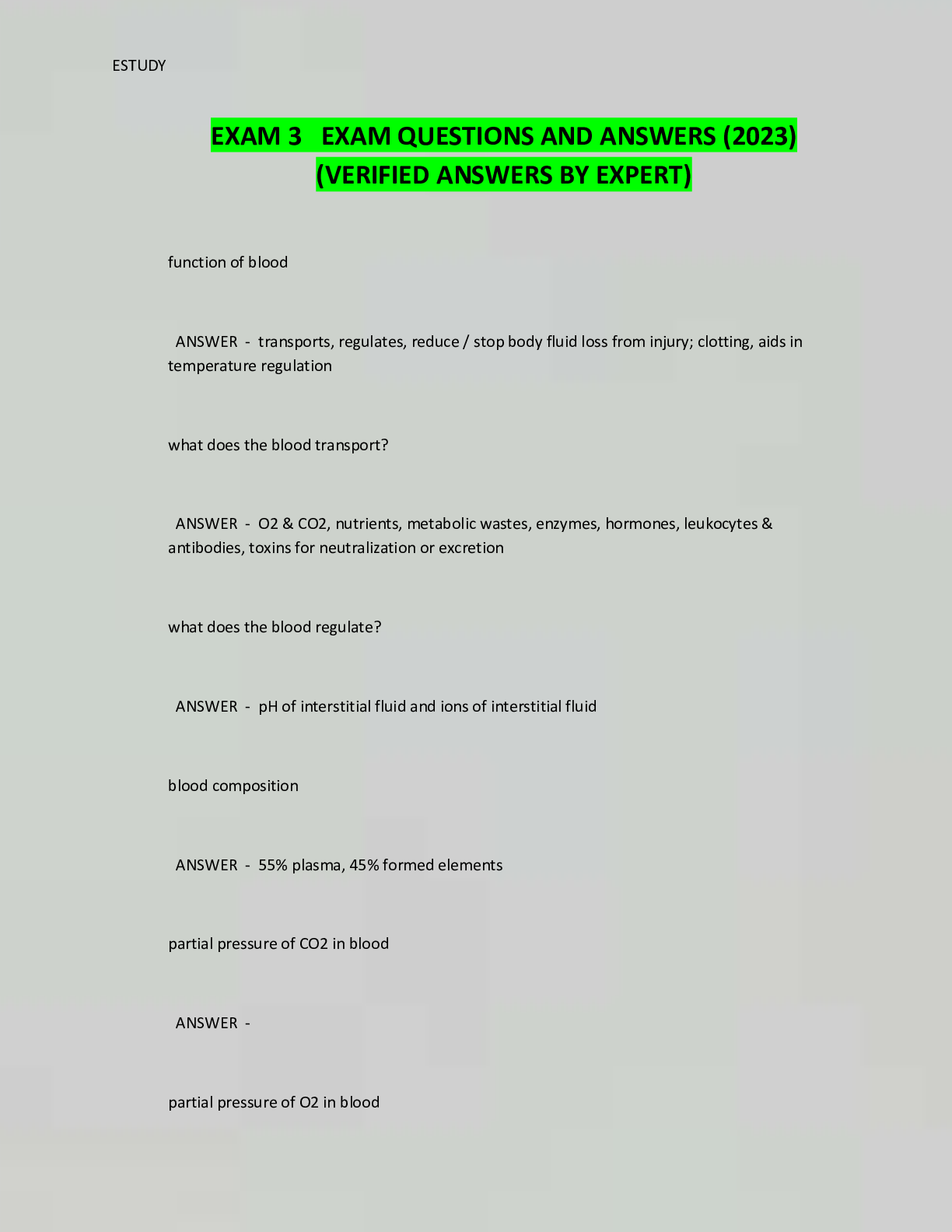
Reviews( 0 )
Document information
Connected school, study & course
About the document
Uploaded On
Sep 06, 2022
Number of pages
22
Written in
Additional information
This document has been written for:
Uploaded
Sep 06, 2022
Downloads
0
Views
41

